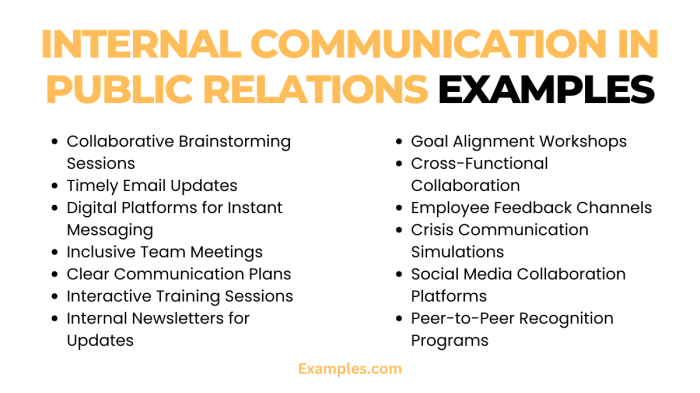
Internal public relations serve as the backbone of effective communication within an organization, facilitating a transparent flow of information between management and employees. This vital aspect not only fosters a positive workplace culture but also significantly boosts employee morale and engagement.
By implementing strategic communication methods, organizations can ensure that their internal messaging aligns with overall business goals, effectively bridging the gap between various departments and creating a unified team. Understanding the nuances of internal public relations is essential for driving organizational success.
Understanding Internal Public Relations

Internal public relations is an essential aspect of organizational communication that focuses on fostering a positive relationship between management and employees. In today’s fast-paced work environment, effective internal communication strategies are crucial in ensuring that employees feel valued and engaged. An organization that prioritizes internal public relations not only enhances employee morale but also boosts overall productivity and commitment to the company’s goals.The significance of internal public relations extends beyond simple communication.
It serves as the backbone for building trust and transparency within an organization. When employees are kept informed about company updates, policies, and changes, they are more likely to feel included and connected to the organization’s mission. This connection fosters a sense of belonging and loyalty, which can lead to lower turnover rates and higher employee satisfaction.
Role of Internal Communication Strategies in Enhancing Employee Engagement
Internal communication strategies play a pivotal role in engaging employees effectively. By utilizing various communication channels and methods, organizations can ensure that their messages resonate with their workforce. Below are key strategies that enhance employee engagement through internal communication:
- Regular Updates: Providing consistent updates about company performance, changes, and future plans keeps employees informed and invested in the company’s success.
- Feedback Mechanisms: Implementing platforms for employees to share their thoughts and feedback encourages open dialogue and makes them feel heard.
- Recognition Programs: Acknowledging employee contributions through recognition programs not only boosts morale but also reinforces a culture of appreciation.
- Team-building Activities: Organizing events that promote teamwork and collaboration helps strengthen relationships among employees and fosters a positive work environment.
- Training and Development: Offering opportunities for professional growth demonstrates an organization’s commitment to employee advancement, leading to higher engagement levels.
Main Components of an Effective Internal Public Relations Campaign
An effective internal public relations campaign consists of several vital components that work together to create a cohesive communication strategy. Understanding these components can guide organizations in developing approaches that resonate with their employees.
- Clear Objectives: Establishing clear and measurable objectives helps in guiding the campaign effectively and assessing its success.
- Target Audience Analysis: Understanding the demographics and preferences of the employee base allows for tailored messaging that appeals to different groups.
- Message Development: Crafting relevant and relatable messages ensures that the communication resonates with employees and aligns with organizational goals.
- Communication Channels: Utilizing diverse channels such as emails, newsletters, intranet, and social media ensures that messages reach all employees effectively.
- Evaluation and Feedback: Regularly assessing the effectiveness of communication efforts and seeking feedback allows for adjustments and improvements in future campaigns.
“Effective internal public relations is about creating a culture of open communication where employees feel informed, valued, and connected.”
Tools and Techniques for Internal Public Relations

Internal public relations play a vital role in fostering a healthy workplace culture and enhancing employee engagement. Utilizing effective tools and techniques can streamline internal communications, facilitate employee outreach, and assess communication effectiveness. This section will delve into specific methods for employing various technologies and strategies to improve internal public relations.
Utilizing Marketing Software for Internal Communications
Implementing marketing software can significantly enhance internal communications by providing structured platforms for information sharing and collaboration. These tools allow organizations to create targeted campaigns, gather feedback, and streamline messaging across teams. The following are key benefits and features to consider when utilizing marketing software for internal communications:
- Centralized Communication: Marketing software can serve as a central hub where employees can access company news, updates, and resources, reducing information silos.
- Segmentation and Targeting: Tools can segment employees by departments or interests, allowing for tailored messaging that resonates with specific groups.
- Analytics and Reporting: Tracking engagement metrics such as open rates and clicks helps in understanding which messages are effective and which need adjustment.
- Feedback Mechanisms: Integrating surveys and polls within marketing software enables real-time feedback from employees, improving overall communication strategies.
Implementing Telemarketing Strategies for Employee Outreach
Telemarketing strategies can be adapted for effective employee outreach, enhancing personal connections and fostering engagement. This method involves direct communication that can be more impactful than emails or newsletters.A detailed guide for implementing telemarketing strategies includes:
Preparation and Training
Equip team members with scripts that reflect company values and encourage authentic conversations with employees.
Targeting Segments
Identify specific employee groups for outreach to ensure messages are relevant and tailored to their interests and roles.
Scheduled Outreach
Develop a calling schedule that respects employees’ time, ensuring calls are made during business hours and are brief yet informative.
Follow-Up
After initial outreach, follow up with employees who expressed interest or had questions, reinforcing connections and demonstrating commitment to employee engagement.
Conducting Market Research for Assessing Internal Communication Effectiveness
Conducting market research is critical for evaluating the effectiveness of internal communications. This process involves gathering data and insights to understand how well messages are being received and what improvements can be made.Establishing a framework for this research includes:
Defining Objectives
Clearly Artikel the goals of the research, such as identifying gaps in communication or measuring employee satisfaction with information flow.
Choosing Research Methods
Select appropriate methods, including surveys, focus groups, and interviews, to gather comprehensive insights from employees.
Analyzing Data
Use quantitative and qualitative analysis techniques to interpret the data, focusing on trends and significant feedback.
Implementing Changes
Based on the findings, develop actionable strategies to address identified issues and enhance communication practices.The effectiveness of internal public relations hinges on the strategic deployment of tools and techniques that foster engagement, streamline communication, and continually assess the impact of messaging within the organization.
Challenges in Internal Public Relations
Internal public relations is a crucial element for fostering a healthy workplace culture and ensuring effective communication between management and employees. However, organizations often encounter various challenges that can hinder the successful execution of these initiatives. Addressing these challenges is vital for improving employee engagement, morale, and overall organizational effectiveness.One of the common obstacles organizations face in executing internal public relations is the lack of alignment between management’s intentions and employees’ perceptions.
Often, there can be a disconnect where employees may not fully understand the company’s vision, which can lead to confusion, misinformation, or even resentment. Additionally, traditional public relations methods, such as top-down communication and infrequent updates, may not resonate with today’s workforce, which increasingly expects more interactive and engaging forms of communication.
Obstacles in Executing Internal Public Relations
Several key challenges can be identified when organizations attempt to implement effective internal public relations strategies. Understanding these challenges is essential for developing successful communication practices.
- Resistance to Change: Employees may be resistant to new communication initiatives, especially if they perceive them as unnecessary or disruptive to their routine. This resistance can stem from a lack of trust in management or past negative experiences with communication efforts.
- Information Overload: In the digital age, employees are bombarded with information daily. When internal communications do not stand out or provide value, employees may overlook or ignore important messages.
- Cultural Differences: In diverse workplaces, varying cultural backgrounds can influence how communication is received and understood. Misunderstandings can arise if messages are not tailored appropriately for different audiences.
- Lack of Training: Employees may not possess the necessary skills to engage with modern communication tools effectively. Without proper training, initiatives can fall flat or not be utilized to their full potential.
Comparison of Traditional and Modern Approaches
Traditional public relations methods often relied on one-way communication, where information flowed from the top down. This approach can create barriers to open dialogue and feedback from employees. In contrast, modern internal communication strategies emphasize two-way communication, fostering engagement and allowing for feedback, making employees feel valued and heard.Modern approaches utilize various digital platforms, such as social media, collaborative tools, and instant messaging, which facilitate real-time communication.
By employing these technologies, organizations can create a more dynamic and responsive communication environment. One example is the use of intranet platforms where employees can share ideas, ask questions, and provide feedback directly, making the communication process more inclusive and effective.
Strategies for Overcoming Misconceptions and Resistance
To successfully implement internal communication initiatives, organizations must address misconceptions and resistance head-on. Effective strategies include:
- Transparent Communication: Being open about the reasons behind internal communication initiatives can help alleviate fears and build trust. Regular updates on the progress of initiatives can keep employees informed and engaged.
- Employee Involvement: Involving employees in the development of communication strategies can lead to greater buy-in. This can be achieved through surveys, focus groups, or feedback sessions that allow employees to express their needs and preferences.
- Continuous Training: Providing ongoing training for both employees and management on effective communication practices ensures everyone is equipped with the tools they need to engage positively with internal communication efforts.
- Tailored Messaging: Customizing messages to align with the various demographics within an organization can help combat misunderstandings and ensure that the communication resonates with all employees.
“Effective internal communication is not just about transmitting messages; it’s about creating a culture of trust and engagement.”
Final Review
In conclusion, mastering internal public relations is crucial for any organization aiming to cultivate a cohesive and motivated workforce. By overcoming communication challenges and leveraging the right tools and strategies, companies can enhance their internal relations, ultimately leading to greater productivity and employee satisfaction.
FAQ Corner
What is the primary goal of internal public relations?
The primary goal of internal public relations is to foster effective communication within an organization, enhancing employee engagement and alignment with company objectives.
How can technology improve internal public relations?
Technology can streamline communication processes, facilitate real-time feedback, and improve collaboration through tools such as intranets, emails, and communication apps.
What are common challenges faced in internal public relations?
Common challenges include resistance to change, lack of clarity in messaging, and the disparity between employee perceptions and management objectives.
How can organizations measure the effectiveness of internal public relations?
Organizations can measure effectiveness through employee surveys, feedback mechanisms, and analyzing engagement metrics to assess the impact of communication strategies.
Why is employee engagement important in internal public relations?
Employee engagement is crucial as it leads to higher productivity, better job satisfaction, and reduced turnover, ultimately benefiting the organization’s overall performance.





